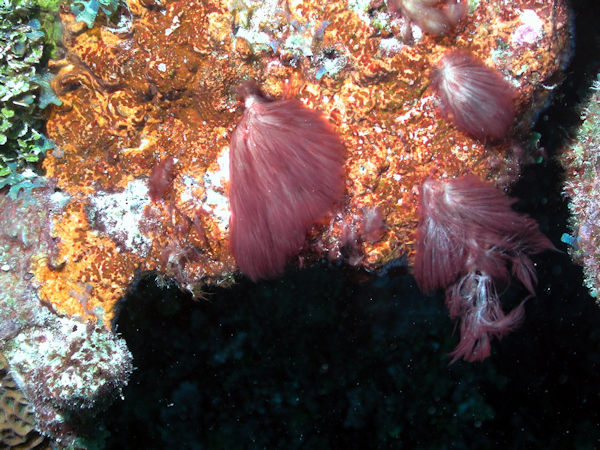SEJournal Online is the digital news magazine of the Society of Environmental Journalists. Learn more about SEJournal Online, including submission, subscription and advertising information.
 |
 |
| Colorful tufts of cyanobacteria, formed by large accumulations of microscopic cells, decorate a Cayman Islands coral reef. Toxins produced by cyanobacteria are detrimental to marine organisms and humans. Photo: Twilight Zone Expedition Team 2007, NOAA-OE. |
Reporter’s Toolbox: Track Harmful Algal Blooms With Data. Avoid Bad Clams
By Joseph A. Davis
At this time of summer, an increasingly common kind of pollution in many places begins making seafood toxic, sickening swimmers and sometimes killing people’s dogs.
We have some databases that can help reporters track “harmful algal blooms.” Also known as red tides, these blooms of particular kinds of algae are harmful to health.
In many places, HABs are getting worse and more frequent. Hence the data — which can help you follow trends.
Summer brings higher water temperatures.
Climate heating often makes it worse.
And the algae people find harmful
grow more abundant in hotter water.
Summer brings higher water temperatures. Climate heating often makes it worse. And the algae people find harmful grow more abundant in hotter water.
Farming, fertilizers and increased stormwater runoff increase pollution from nutrients like phosphorus and nitrogen that make the algae grow. Salinity can also be a trigger.
The worst villains are blue-green algae — which are not technically algae at all. They are cyanobacteria, actual bacteria that photosynthesize.
Among other things, they produce toxins like microcystins and domoic acid that make people and other creatures sick. To be fair, they also played a key role in creating the oxygen atmosphere that made life on land possible.
There’s much more to know about the many kinds of HABs. For now, let’s talk about the data.
Where the data comes from
There are several potential sources of HAB data; none of them is perfect. Let’s look at each.
- Harmful Algal BloomS Observing System (HABSOS; the funny S is intentional). This system is run by the National Oceanic and Atmospheric Administration. It’s online, open and searchable. It gives you individual events, presented in map format via ArcGIS. Its biggest limitation is that it only looks at the Gulf of Mexico.
- Harmful Algal Event Database (HAEDAT). This system is run by agencies within UNESCO. It is worldwide in scope. Data is as reported by member nations — which creates comparability and accuracy issues.
- U.S. National Office for Harmful Algal Blooms. Based at the Woods Hole Oceanographic Institute in Massachusetts and funded by NOAA, this office is an international research clearinghouse. Their data does go into HAEDAT, but they present it better. Events are mapped to areas in the U.S. and separated according to type of toxic organism.
How to use the data smartly
Of course you can use the data to look at time-trends — are they getting worse with climate heating and higher water temperatures? (Spoiler alert: they are.)
This may be meaningful for some purposes. At a global and national scale, it really matters. The U.S. Environmental Protection Agency is among those already doing a pretty good job of explaining the climate connection.
But there is more to report about than just the global heat wave. Your audience may be interested in more immediate impacts, and the data can help you tease these out.
For example, your publication may be located in an area where tourism is a big industry and swimmable beaches have economic importance. You could overlay HAB data with data on beach closures.
Or you may live in Ohio, where a shallow and warm Lake Erie receives ag runoff polluted with nutrients. Tom Henry at the Toledo Blade has written for years about how algal blooms have threatened the city’s drinking water. This happens elsewhere, too. It’s a reminder that many HABs happen in the Great Lakes and many smaller inland lakes.
Some of the organisms that cause HABs cause
shellfish poisoning — posing a serious health risk
to anyone who eats the affected seafood.
In other places, seafood may be an economically or culturally important industry. Some of the organisms that cause HABs cause shellfish poisoning — posing a serious health risk to anyone who eats the affected seafood.
Dead zones are better known to the people who suffer their effects than to the people (e.g., farmers) who cause them. Fertilizer running off of fields and flowing down the Mississippi nourishes algae and other plants growing in the Gulf. When algae die, bacteria consume them and rob the waters of oxygen.
Dead zones happen in other waters, too. Of course the dead zone is not toxic to humans. Just to fish.
[Editor’s Note: For more on algae, see our comprehensive Issue Backgrounder, TipSheets that focus on algal blooms as a local story and that cover algae and beach closures, an FEJ StoryLog on one reporter’s experience reporting on algae, plus BookShelf reviews of volumes about phosphorus and algae and about algae and the Great Lakes. And don’t forget to regularly check the latest algae news with headlines from EJToday.]
Joseph A. Davis is a freelance writer/editor in Washington, D.C. who has been writing about the environment since 1976. He writes SEJournal Online's TipSheet, Reporter's Toolbox and Issue Backgrounder, and curates SEJ's weekday news headlines service EJToday and @EJTodayNews. Davis also directs SEJ's Freedom of Information Project and writes the WatchDog opinion column.
* From the weekly news magazine SEJournal Online, Vol. 9, No. 29. Content from each new issue of SEJournal Online is available to the public via the SEJournal Online main page. Subscribe to the e-newsletter here. And see past issues of the SEJournal archived here.













 Advertisement
Advertisement 



